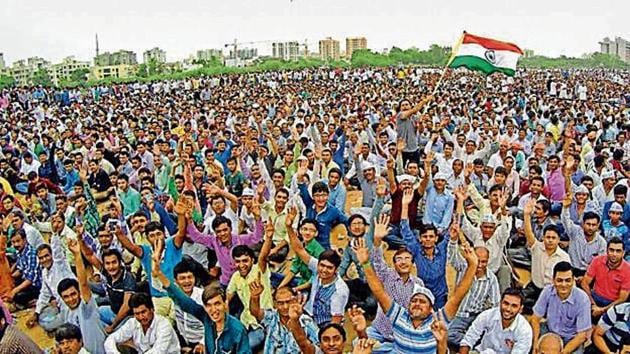Gujarat elections: How the Patidar vote stacks up
Patels don’t always vote as a homogenous unit and there is competition between the two big sub-groups, Leuvas and Kadvas, in all spheres, including politics.
In January 2012, thousands of devotees from the powerful and influential Leuva Patel community gathered at Khodaldham on the outskirts of Rajkot for a religious function.

The meeting was convened by the Shree Khodaldham Trust to lay the foundation stone for a huge temple to goddess Khodiyar that would unite the Leuva Patel community.
Trust chairman Naresh Patel presided over the meeting, which was attended by former BJP strongman and ex-CM Keshubhai Patel who was chief guest and the only politician to speak from the dais. The event was a launch pad for Patel who soon floated his Gujarat Parivartan Party (GPP), targeting then chief minister Narendra Modi’s government.
The new party won two seats while the BJP secured majority with 115 seats. In the entire campaign, Modi did not once mention Keshubhai or other detractors who had joined the GPP.
It did not end there. Modi, who had replaced Patel as chief minister of Gujarat in 2001, went to meet his predecessor immediately after the election results were declared to seek the latter’s blessings.
Two years later, while Keshubhai announced retirement from active politics citing age and health issues, his GPP merged with the BJP. Prior to this, his son Bharat Patel had already joined the ruling party.
Five years later, the BJP is once again facing a challenge from the influential Patidar community that has solidly supported the party for the last 22 years. But this time around, instead of a seasoned politician the challenger is a young Hardik Patel, convenor of the Patidar Anamat Andolan Samiti (PAAS).
The 24-year-old youth who has been at loggerheads with the BJP government over the Patidars’ demand for quota in government jobs and education, has pledged to defeat the saffron party in the upcoming elections. PAAS has pledged its support to the Congress in these polls after it accepted the latter’s formula for giving reservation to the Patel community.
The Patidars form about 11-12% of the population, according to last-recorded caste-wise census of 1931, and are the largest caste in Gujarat after the Thakors. One of the most influential and dominating castes, about 80% of the Patidars are Leuva and Kadva Patels, followed by the Anjana and Matiya Patel sub-castes who have already got OBC status.
So, do the Patels vote as one homogenous unit?
Hardik belongs to the Kadva Patidar community and according to a state BJP leader the party is confident that the Leuva Patels will vote for the BJP while there will be a split in the Kadva votes.
“The impact of Hardik Patel will be similar to what happened to GPP in 2012,” he said on conditions of anonymity.
Interestingly, on Thursday Hardik posted a picture on Twitter of his meeting with the Khodaldham Trust chairman Naresh Patel. The Trust, however, maintained that the meeting was non-political.
There are about 16 seats (out of 182) where Patidars are in majority, of which nine are in Saurashtra, three in north Gujarat and four in Surat. Of these, seven seats in Saurashtra and three in Surat are dominated by the Leuva Patels, according to internal analysis by political parties. There are, however, close to 55 seats where Patels will be a major factor.
The BJP has fielded 29 Leuva Patels and 23 Kadva Patels, while the Congress has 26 Leuva and 21 Kadva candidates.
Ahead of filing his nomination from the Rajkot West seat, chief minister Vijay Rupani sought the blessings of Keshubhai, a Leuva Patel. Prime Minister Modi in one of his campaign rallies in Gujarat on November 27 accused the Congress of being anti-Patel.
He claimed that the Congress removed Chimanbhai Patel as chief minister when he started asserting his identity. Modi also blamed the Congress for the removal of two state BJP CMs, Keshubhai and Anandiben Patel, through its defamatory and disruptive tactics.
Earlier in November, Modi visited the silver jubilee event at Akshardham Temple of the Bochasanwasi Shri Aksharpurushottam Swaminarayan Sanstha (BAPS) in Gandhinagar. A large number of followers of BAPS are from the Leuva community and Modi’s visit was seen as an attempt to reaching out to them.





